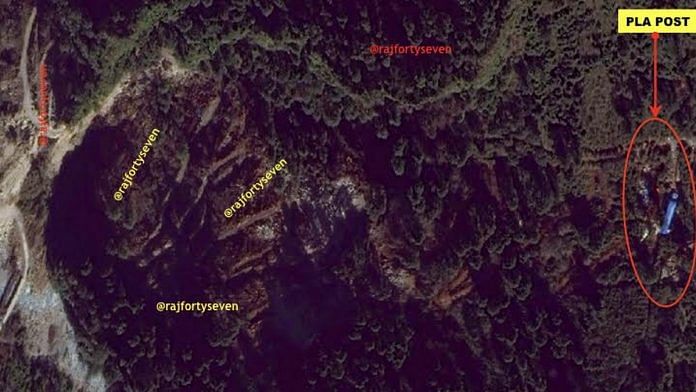
New Delhi: China has managed to build a village on land occupied by the People’s Liberation Army (PLA) by overrunning an Assam Rifles post in 1959 on the disputed frontier in Arunachal Pradesh and not on territory controlled by India, sources in the defence and security establishment said.
They said the village on the disputed border in Upper Subansiri district was on territory under Chinese control. Beijing has, for years, maintained an Army post on this territory and the various constructions by the Chinese haven’t happened suddenly, the sources added.
“Even after the 1962 war, they did not withdraw from the area, and it continued to be under Chinese control, just like Aksai Chin, where they have built airfields and other military establishments,” a source said.
ThePrint had, in June 2018, reported on the basis of satellite images that the Chinese PLA had moved at least 5 km inside what was Indian territory, and was setting up base in the strategic Tsari Chu valley, where the village has come up now.
Fresh satellite images of the village, located on the banks of the river Tsari Chu were put out by NDTV Monday. Images from 26 August 2019 don’t show any village, but those from 1 November 2020 do.
Also read: China releases 5 ‘abducted’ Arunachal Pradesh youths to India
Chinese attack in 1959
China’s 1959 operation is known as the Longju incident, and has been chronicled in the book 1962 War – The Unknown Battles: Operations in Subansiri and Siang Frontier Divisions, by retired major generals G.G. Dwivedi and P.J.S. Sandhu.
The book states that the Tibetan rebellion broke out on 10 March 1959, and was brutally suppressed by the PLA. The 14th Dalai Lama escaped and entered Indian territory on 31 March along with some followers, and was subsequently granted political asylum by India.
“This upset the Chinese authorities a great deal, as they felt that the rebellion had been instigated by India, and was aimed at securing ‘independence for Tibet’,” the major generals state.
The book also notes that the Indian post at Longju irked the Chinese, and in a note dated 23 June 1959, they accused Indian troops of intrusion and occupation of Migyitun and some other places in Tibet, and collusion with Tibetan rebels.
“It was at Longju in the Subansiri Frontier Division that the first armed clash took place between the PLA (2nd Company of 1st Regiment of Shannan Military Sub Command) and personnel of 9 Assam Rifles occupying the Indian post at Longju on 25 Aug 1959 which resulted in two Indian casualties,” the book states, adding that the issue was finally resolved through diplomatic channels, and both sides “withdrew from the area” on 29 August 1960.
“However, after this incident, with effect from 27 Aug 1959, the defence of NEFA which till then was the responsibility of Intelligence Bureau (IB) under the Ministry of Home Affairs and Assam Rifles under the Ministry of External Affairs became the responsibility of the Indian Army. Though Assam Rifles was to continue to remain deployed on the border but henceforth, it would be under the operational control of the Army,” it says.
The book adds that after the Longju incident, Assam Rifles did not reoccupy the post, and instead, set up a post at Maja, 10 km to the south, on 29 August 1959.
PLA set up a post in disputed area in late 1990s
According to ThePrint’s 2018 report cited above, in the late 1990s and early 2000, the Chinese PLA had started a campaign to improve its border roads, especially in eastern Tibet, close to the Chumbi Valley, Bhutan and Arunachal Pradesh.
In the same period, in the Tsari Chu area, the PLA had established a company-level post at least 3 km inside Indian territory. At the time, the post was hardly an administrative barracks, with a jeep track serving it.
Located on the eastern side of the river, at a height of 2700 m, the post had three barracks arranged in a C-shape, with a small listening post slightly ahead. With the passage of time and India’s continued indifference, the PLA was encouraged to extend the track further with a bridge and another hut at around 2600m height on the west side of the river, the report added.
Also read: BJP MP flags China ‘encroachment’, says ‘don’t allow next Doklam in Arunachal’
